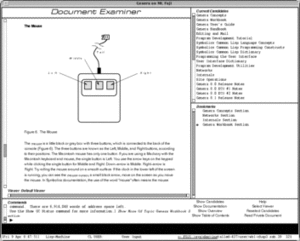Symbolics Document Examiner
Symbolics Document Examiner is a powerful and early hypertext system developed at Symbolics (a manufacturer of high-end workstations) by Janet Walker in 1985. The Symbolics Document Examiner was first used for a hypertext implementation of the Symbolics manual in the sixth release of the Genera operating system, and was well liked, winning an award from the Society for Technical Documentation.[1]
History

The Symbolics manual was an 8,000 page document that was represented in a 10,000 node "hyperdocument" containing 23,000 links in all. The entire manual required 10 MB of storage space - a significant amount in 1985, even on the Lisp machines Symbolics sold. The Symbolics Document Examiner used a hierarchical structure, which differed from other experimental hypertext systems; it apparently was partially inspired by an even earlier hypertext system, the precursor to Texinfo which originated with Emacs.[2]
Symbolics Document Examiner users could add bookmarks, which allowed returning to specific items easier; this method was later incorporated in graphical web browsers. The system also supported on-line substring searching. The biggest drawback to the Symbolics Document Examiner was that users could not make changes to any information or to a document's navigation.
The authoring environment for the Document Examiner was Symbolics Concordia. With Symbolics Concordia it was possible to edit all documentation.
References
- "The Document Examiner included with Release 6 won an award from the Society of Technical Documentation. The Symbolics Graphics Division introduced S-Paint, S! ! -Geometry, S-Render, and S-Dynamics as part of an integrated video-compatible image-making and image-processing facility." "Symbolics Technical Summary Archived 2006-09-08 at the Wayback Machine", 1985
- "We saw no reason to have the underlying information structure be reflected in the user interface model unless that structure was a good model for interacting with information. My experience in trying to help users with a tree-structured information interface (the INFO subsystem in EMACS) led me to believe that a book-like interface would be more palatable for many people." pg 8 of Janet H. Walker's "Document Examiner: Delivery Interface for Hypertext Documents". 1987, Proceedings of the ACM conference on Hypertext